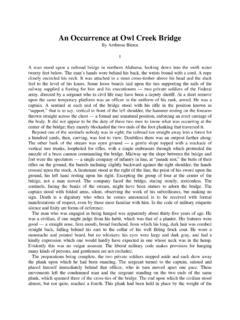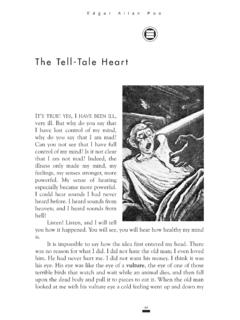Transcription of THE LING SIX Sound Check - Advanced Bionics
1 What is the Ling Six Sound Check ?The Ling Six Sound Check is an easy-to-use tool that evaluates how well children are hearing with their cochlear implant and/or hearing aid. The test is a behavioral listening Check that uses simple sounds to detect changes in the quality of a child s hearing. The test should be completed at the start of each school day or therapy session and any time you suspect a child is not hearing as well as they normally do. The sounds used for the Ling Six Sound Check are ahh , eee , ooo , mmm , shh , and sss . These sounds approximately cover sounds ranging from 250-4000 Hz and represent speech in the low, mid, and high frequencies. The chart below describes how these sounds broadly represent the sounds needed to hear spoken the child has the ability to hear:They should be able to detect:Up to 1,000 Hz ahh eee and ooo Up to 2,000 Hz sh Up to 4,000 Hz s How do I Complete the Ling Six Sound Check ?
2 Verify the child s equipment is on and set at the appropriate settings. Sit beside the child. Younger children can be seated in a high chair. Always position yourself on the child s better hearing side. If you are using an auditory screen, hold it about four inches in front of your mouth so your mouth is completely covered. Using a normal speaking level, say each of the sounds so that they can be discriminated through listening alone. Make sure you are not providing any visual cues such as raising your eyebrows or other facial movements and that the child cannot lip-read. Each of the sounds should be presented for the same length of time without rising or falling pitch. After presenting each Sound , wait for the child to respond in a manner that is appropriate for their age (see the Considerations for Different Ages section below for further information). Present all six sounds at least three times in random order.
3 Vary the length of your pauses. Occasionally make no Sound at all, allowing nothing to be an appropriate response. Keep track of the child s responses so you can compare performance over time. AB Makes it Simple For Schools:AB Makes it Simple For Schools:Download the Tools for Schools Behavioral Listening Check tracking form to record responses to the Ling 6 Sound Check . Visit your own auditory screen. Visit The Listening Room rehabilitation website at and search for The Ling Six Sound Screen Assembly Instructions THE LING SIX Sound CheckTMBEHAVIORAL LISTENING CHECKForm for recording a child s responses to the Ling Six sounds Child s Name: Age: Date: Cochlear Implant (CI): Right Ear Left Ear Both Ears Hearing Aid (HA): Right Ear Left Ear HA Settings: CI Settings: Technique Used: Detection Discrimination Identification Response Used: Behavioral Conditioned Play Pointing Repeating Presentation Level: Whisper Normal Voice Loud Voice Distance: 3 feet 6 feet 12 feet Reliability: Good Fair PoorLing SoundMondayTuesdayWednesdayThursdayFrida ySaturdaySundayAHEEOOSHSMS ilenceNote: Remember to present the Ling Six sounds in random order and to vary your length of presentation so that the child does not provide false BionicsFor questions or additional information.
4 Toll Free TTY Monday through Friday, 5am to 5pm PST Web Email 027-M607-03 2015 Advanced Bionics AG and affiliates. All rights reserved. Considerations for Different AgesThe Ling Six Sound Check can be used with children of different ages and various auditory skill levels. Babies and very young children will provide responses that allow you to confirm detection and possibly discrimination. Older children will provide responses that allow you to confirm identification. Keep in mind that a child who is a new recipient of a cochlear implant or hearing aid will begin with detection tasks and then progress to discrimination and identification tasks as appropriate. Below is a description of the auditory skill levels you can test with the Ling Six Sound Check :Auditory Skill LevelDescriptionDetectionRecognizing the presence or absence of soundDiscriminationDiscerning if two or more sounds are the same or differentIdentificationReproducing a Sound or pointing to a picture of the Sound heardBabies (Detection Task) When babies hear one of the Ling Six Sounds presented, they may respond through a behavioral cue such as eye widening, turning their head, or displaying a change in sucking behavior if using a pacifier or having a bottle.
5 Keep in mind the baby must be able to consistently repeat these types of behavioral responses when Sound is presented for the response to be considered valid. Very Young Children (Detection Task) Very young children can be taught to respond each time they hear by dropping a block in a bucket, pointing to their ear, or raising their hand. These methods are called Conditioned Play. Instructions on how to train children to complete a detection task using a Conditioned Play response are Children (Discrimination and Identification Task) Yo u can help young children respond using a higher-level discrimination or identification response with the use of toys. It is easy to find toys to represent each of the Ling Six Sounds. For example, an airplane for the ahh Sound and a snake for the sss Sound . Instructions for how to train children to complete a discrimination or identification task are below. Older Children (Identification Task) Older children can respond by pointing to a picture card that represents each Sound or by simply repeating what was heard.
6 AB Makes it Simple For Schools:Download the Tools for Schools Ling Six Sound Flash Cards or Ling Six Sound Flyer Visit Children to Complete the Ling Six Sound CheckTraining for DetectionConditioned Play can be used to teach children how to complete a detection task. To begin teaching children how to complete Conditioned Play, do the following: Sit beside the child. Younger children can be seated in a high chair. Always position yourself on the child s better hearing side. Allow the child to use lip reading and visual cues while you complete training. Hold a block next to the child s ear or help get the child in the correct posture for listening and responding appropriately for the task you are training. Each time you say one of the Ling Six Sounds, help the child drop the block in the bucket, raise their hand, or complete the desired conditioned play response you are training the child to do.
7 It is often helpful to present the Sound , pause, and look expectantly at the child. Use an excited facial expression, point to your ear and say I heard that! After several rounds of helping the child to respond in the appropriate way, say the sounds, look expectantly at the child, and see if the child will perform the required task on their own. Continue to allow the child to use lip reading and visual cues during this stage of training. Remember to train the child that no Sound is possible and nothing can be an appropriate response. You can model how to indicate nothing by shaking your head back and forth and saying I don t hear a Sound . Use the Auditory Sandwich to help transition the child to an auditory only task (Instructions below). Once the child is consistently responding you should eliminate all visual and lip reading cues. You are ready to complete the Ling 6 Sound Check .
8 Training for Discrimination and IdentificationTo begin teaching children how to complete a discrimination and identification task, do the following: Gather the appropriate toys or picture cards to represent the Ling 6 Sounds. Sit beside the child. Younger children can be seated in a high chair. Always position yourself on the child s better hearing side. Allow the child to use lip reading and visual cues while you complete the training. Start with two objects such as an airplane for ahh and a baby for shh . Point to or hold up the object and say the corresponding Sound . Hold up the other object and say the corresponding Sound . Do this several times. While teaching each Sound , use lots of intonation in your voice to highlight the sounds. As you hold up the object, encourage the child to make the corresponding Sound with you. It is often helpful to hold the object in front of you, say the Sound , and then put the object in front of the parent who will model the Sound , then in front of the child, pause, and allow the child a chance to say the Sound .
9 Eventually say the Sound without holding or pointing to the object and see if the child will point to or pick up the corresponding toy or picture card on their own. Continue to allow the child to use lip reading and visual cues during this stage of training. Add in additional sounds and their corresponding toy or picture as the child gets comfortable with the task. If the child is not ready for a set of six choices, keep the set size small and continue to train the child on how to complete the task. Gradually increase the set size to 6. Remember to train the child that no Sound is possible and nothing can be an appropriate response. You can model how to indicate nothing by shaking your head back and forth and saying, I don t hear a Sound . Use the Auditory Sandwich to help transition the child to an auditory-only task (Instructions below). Once the child is consistently responding, you should eliminate all visual and lip reading cues.
10 You are ready to complete the Ling 6 Sound Check . Advanced BionicsFor questions or additional information: Toll Free TTY Monday through Friday, 5am to 5pm PST Web Email 028-M740-03 2016 Advanced Bionics AG and affiliates. All rights reserved. It is important to pause when doing the Ling 6 Sound Check and allow children to indicate they do not hear any Sound . Training children that no Sound and nothing are appropriate responses is an important part of the Ling 6 Sound Check . Helping Children Transition to an Auditory-Only Task Using the Auditory Sandwich: LISTEN ALONELISTEN WITH SUPPORTLISTEN ALONE Listening Alone (Top Slice of Bread) - Present the Ling Six Sounds initially auditory-only with no visual information or cues. Listening with Support (Meat and Veggies) - If the child is unable to provide the correct response, present the information again using visual cues such as lip reading, or pointing to the corresponding toy or picture card.





